Neck Pain
(Part 1) |
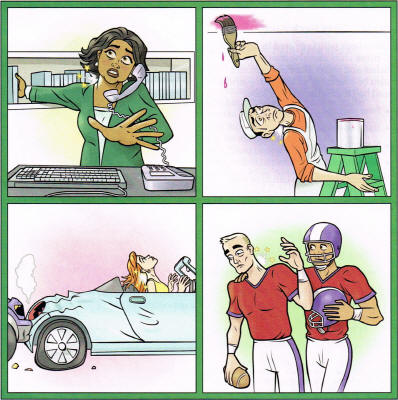
A Real Pain in the Neck
If you suffer from neck pain, you're not alone. Many people
have neck pain
at some point in their lives. Problems such as poor
posture, injury, and wear and tear
can lead to neck pain. This
article can help you learn how to care for your neck.
Pain is a Problem
Pain is a way the body tells you that it needs
attention.
Like a flashing warning light in a car,
neck pain tells
you that there's a problem. The pain can be sharp, dull or achy.
This pain is often a result of an accident or years
of poor neck health.
|
|
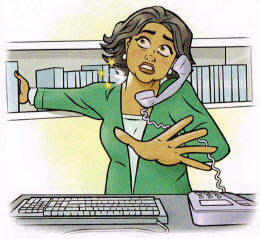 |
What Causes Neck Pain?
Some neck pain is caused by an injury.
Getting older can
also mean more
aches and pains. But neck pain can
also
be caused by
strain from overuse
and bad habits that
can include:
● Poor posture
●
Bad body mechanics
● Not enough exercise
● Repetitive motion
With proper care, you can help your neck feel
better now and prevent pain in the future.
|
The Road to Recovery
Resting a painful neck can feel good.
But not using your neck can cause
muscles to stiffen and weaken.
Instead, neck exercises that stretch
and strengthen your neck muscles
can help you get relief. Check
with your healthcare provider
before trying new exercises.
This way, you're sure to get started
safely on the road
to recovery.
When to Seek Medical Care
Seek medical care right away
if you have any of the following:
●
Numbness, tingling, or
weakness in other parts of the body, especially in the
shoulder, arm or hand
●
Neck pain that doesn't go away or gets worse
Your Goal: A Pain-Free Neck
There are things you can do to
help prevent or relieve neck
pain. For example, you can change
habits that lead
to neck pain or
make it worse. Improving your posture,
body mechanics and overall health
may lessen pain or even make it
go away. Most people who make
these changes feel better. It does
take time and effort. But your goal
of a pain-free neck will be well worth it.
|
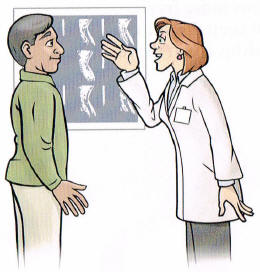

|
|
Anatomy of the Neck
A healthy neck lets the head, shoulders and arms move freely. Strong
neck muscles
help support the head and keep the spine aligned for good posture.
When the neck is healthy, it can move without causing pain.
Muscles of the Neck
Neck muscles work with muscles in the shoulders, chest and back to hold up
the head.
These muscles hold vertebrae in place and help you move freely.
Keeping all these
muscles strong and flexible helps support the bones, joints and ligaments
in your neck.
Reducing stress and strain on these muscles can also help keep your neck
pain-free.
How the Neck Moves
The head and neck move in three basic ways: flexion and
extension, rotation and lateral
bending. How far you can move in each direction is your
range of motion.
To avoid
injury, stay within a range of motion that's comfortable for you.
|
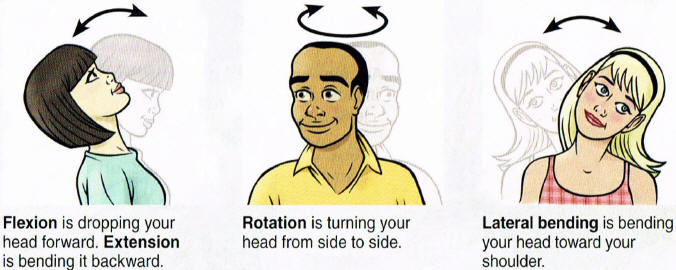
|
|
When a Good Neck Goes Bad
A healthy neck can become unhealthy for many reasons. For
example, aging can cause wear
and tear on the disks and vertebrae and
lead to neck pain. Strain on the neck from overuse,
repetitive motion and bad body mechanics can also lead to disk and bone problems.
Common Bone Problems
Over time, the lining of smooth cartilage on joints can wear out.
This is called
arthritis.
Arthritis can cause pain, swelling and
stiffness in the neck. Arthritis in facet joints makes it
harder
to move the neck without pain. Rubbing vertebrae can also cause
growths
of bone (bone spurs) to form. If bone spurs press on
nerves, pain can result.
Accidents Can Happen: Injuries and Pain
Certain types of accidents can
result in painful neck injuries. These accidents often occur
while driving or playing sports. The neck is injured because
it is forced past its normal
range of motion. These injuries
include whiplash, strains and sprains.
|
Whiplash
Whiplash is injury to different parts of the neck,
such as muscles,
ligaments or joints. The most common cause of whiplash is a car
accident. But it can also happen during a fall or sports injury.
Whiplash can result when an impact throws the head, forcing the neck too
far forward (hyperflexion),
then too far backward (hyperextension).
When combined, the two motions can cause a painful whiplash injury.
Strains and Sprains
Strains (stretched or torn muscles) and sprains (stretched or torn
ligaments) can cause neck pain. Strains and sprains can occur
during an accident or when the neck is overused through repetitive
motion. They can also cause muscles and ligaments to become
inflamed (swollen and painful).
Pain in Other Areas
of the Body
Pain from a neck injury is sometimes felt in other areas
of the body, such as the shoulders or upper back.
For example, a neck injury can cause headaches. Pain, numbness or
tingling in the upper back, arms
or hands
also can result. Talk to your healthcare provider if you have pain
in areas other than your neck. It may be
caused by your neck condition.
|
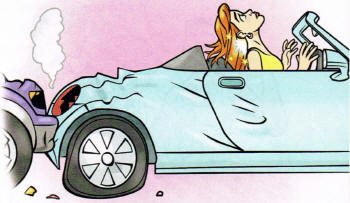
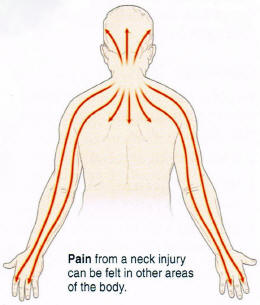
|
|
Your Evaluation
A
medical evaluation can help find the cause of your neck pain.
It can also help your healthcare provider decide on the best treatment for
you.
The evaluation may include a health history, physical exam and diagnostic
tests. |
|
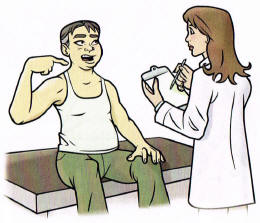
|
Health History
Questions the healthcare provider may ask you include:
●
Where is your pain? How often does it bother you?
●
How and when did your pain start?
●
What relieves the pain? What makes it worse?
●
What
kind of work do you do? What are your
hobbies?
●
How does neck pain affect your life?
|
Physical Exam
Your healthcare provider can learn a lot by looking at your neck in
different positions. He or she may check your posture, muscle
strength, sensation, flexibility and reflexes. Depending on your
symptoms, diagnostic tests may be needed to find the cause of your neck
pain.
Diagnostic Tests
You may have one or more of these tests to get more information about
your neck problem:
●
X-rays
to look at vertebrae
●
MRI
or
CT scan
to look at disks and other soft tissue
●
EMG
and
NCV
to measure muscle and nerve function
|
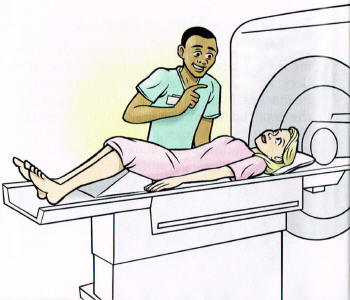
|
|
Caring for Your Neck
Inflammation
and swelling of neck muscles can cause neck pain.
This can also trigger spasms (sudden tightening of muscles) in
the neck. These can make pain even worse. There are steps
you can take to help relieve neck pain at home.
|
|
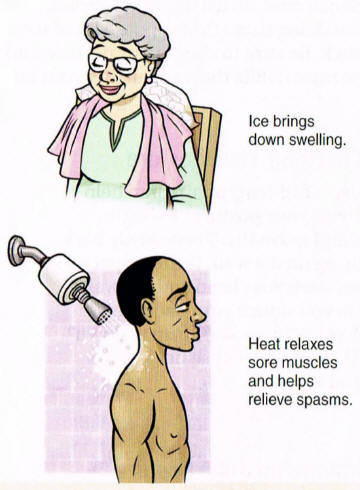
|
Home
Relief for Neck Pain
Pain can end quickly or last awhile. Either way,
you'll want
relief as soon as possible. Your healthcare provider can tell you
which treatments to do at home to help relieve your pain.
●
Lying
down
for a short time takes pressure from
the
head off the neck.
●
Ice
and
heat
can help reduce pain. To bring down
swelling, rest an ice pack wrapped in a thin towel on your
neck. To relax sore muscles, apply a warm, wet
towel to the area. Or take a warm bath or shower.
●
Over-the-counter medications,
such as ibuprofen,
aspirin, naproxen and acetaminophen, can help reduce
swelling. Use these only as directed.
●
Exercises can relax muscles and prevent stiffness.
To
prepare, drape a warm, wet towel around your neck
and shoulders. Remove the towel. Then do
the
range-of-motion exercises in this article as directed by your doctor.
|
Relieving Stress
Stress can cause physical reactions, such as tense neck muscles or
spasms. The following can help keep stress in check:
●
Get
enough sleep.
When you're tired, it's harder to cope
with stress. To help you sleep, try reading or listening to soothing music before bed.
●
Eat right.
Good food choices help make your body healthier. A healthy body is better able to deal with
stress.
●
Be
active.
To reduce stress, try to walk, jog or swim on most
days. Yoga and tai chi may also help you relax.
●
Breathe deeply.
Inhale through the nose. Take in as much
air as you can, while pushing out your lower belly. Then exhale slowly through your mouth until
your lungs feel empty. Do this 3 to 5 times, or until you
feel relaxed.
|
|
Top of Page |



![]()
![]()